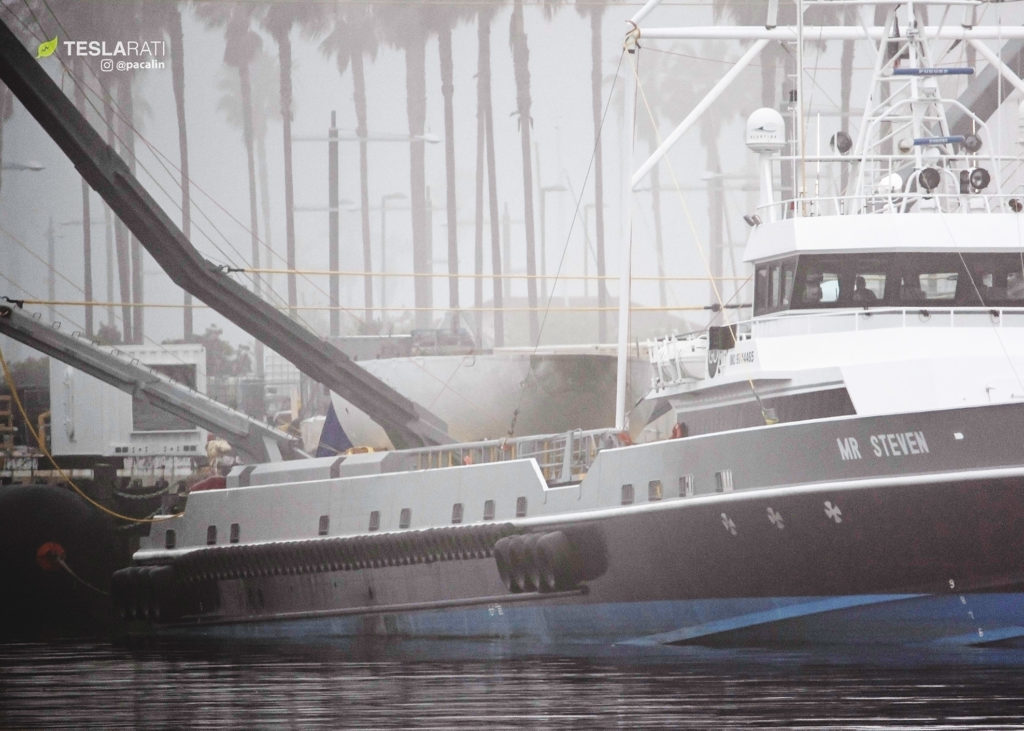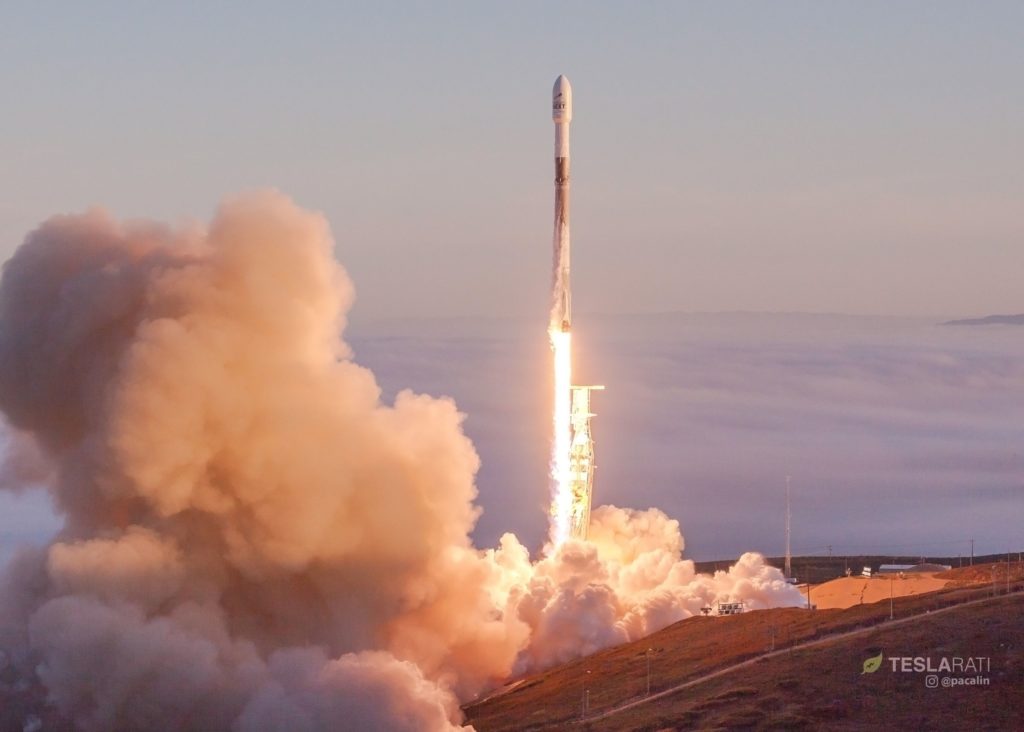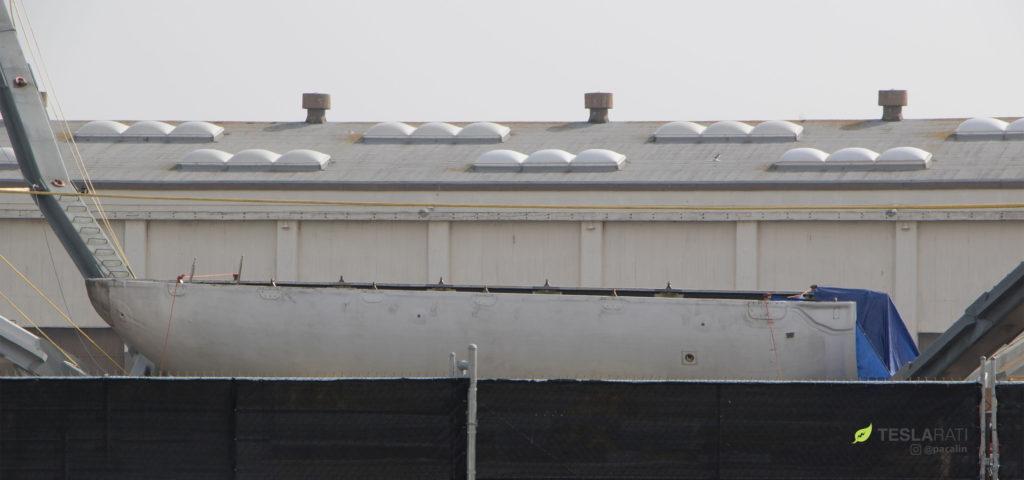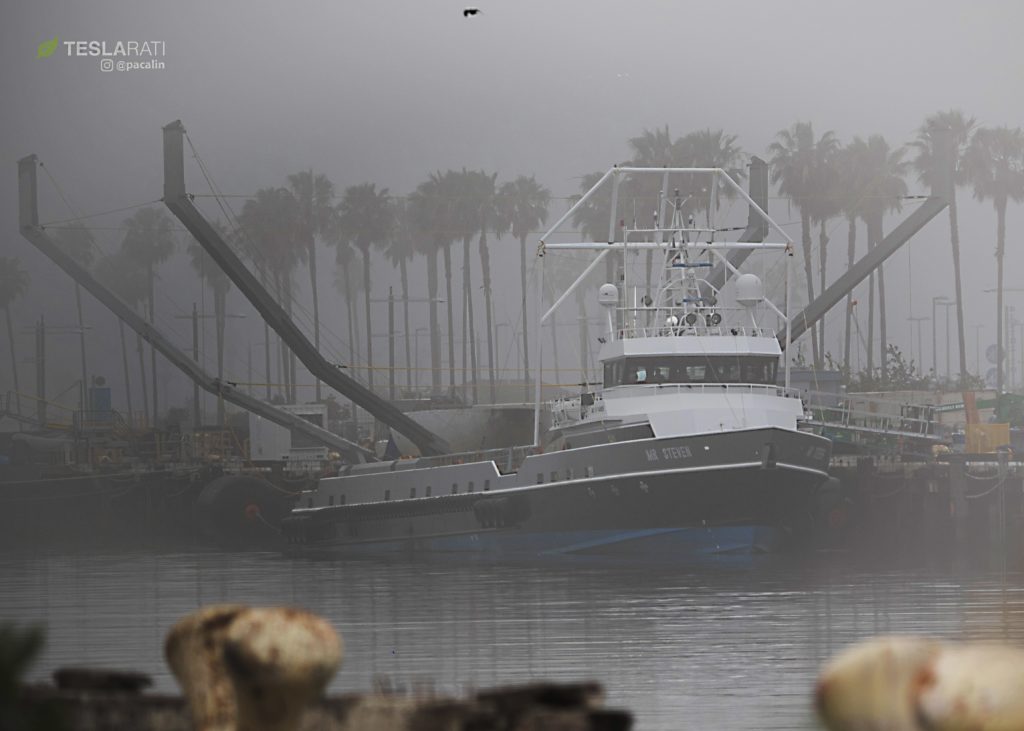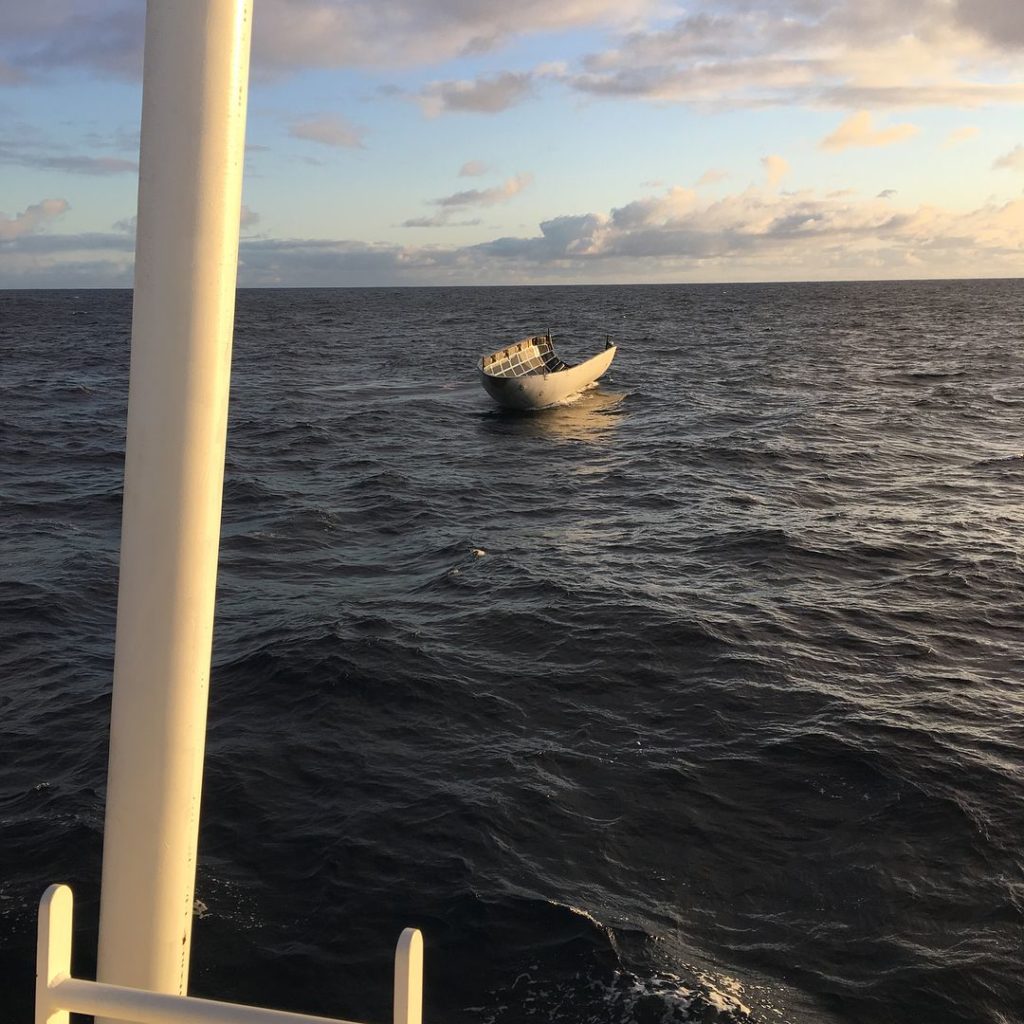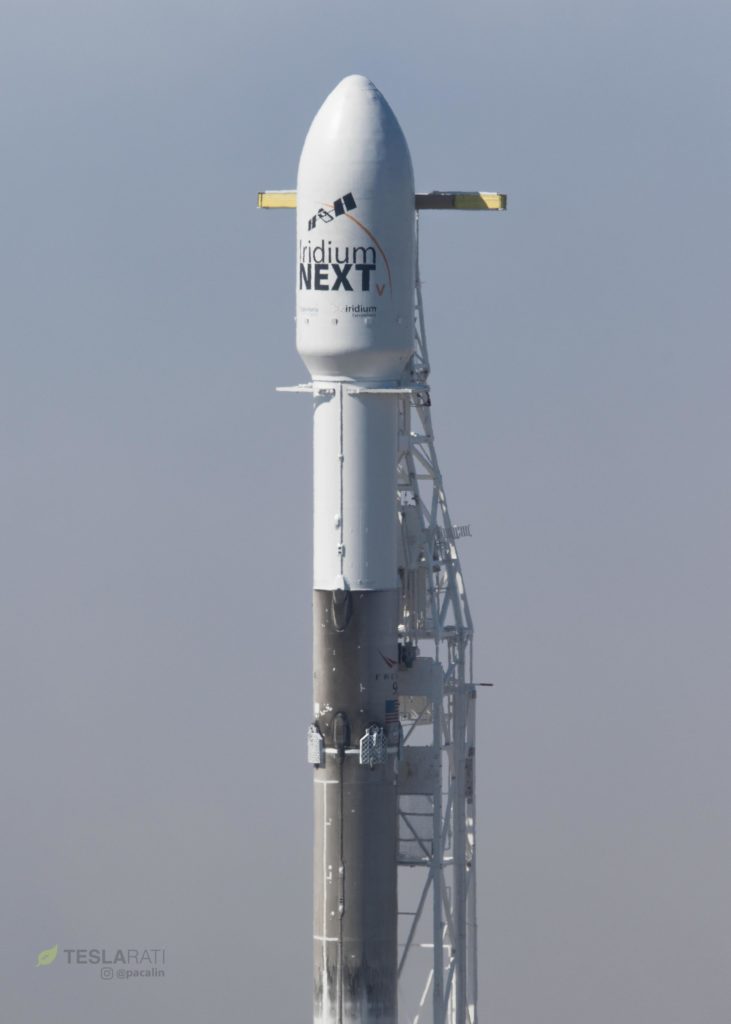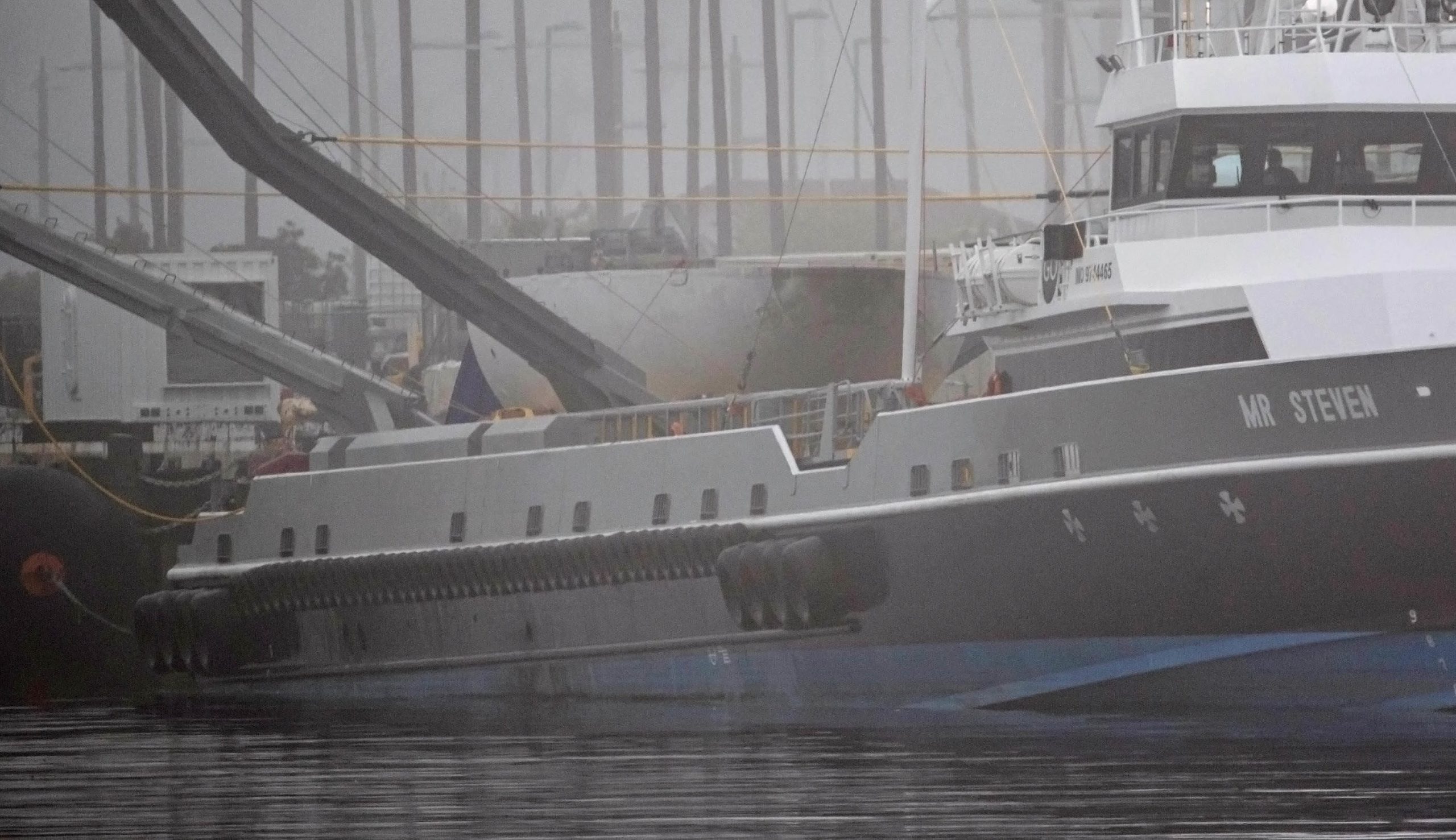
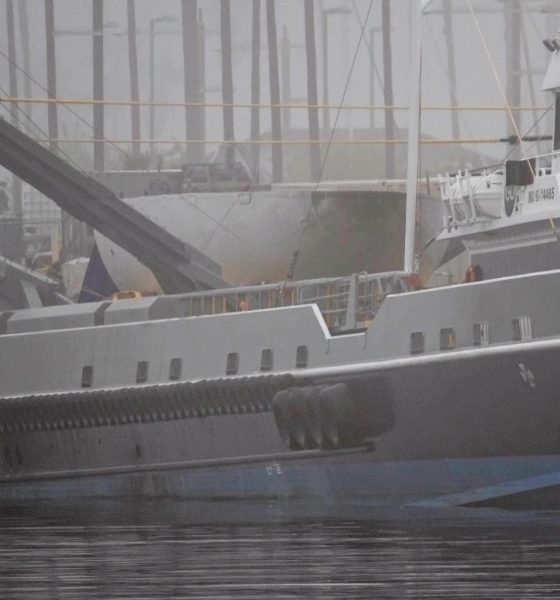
News
SpaceX returns intact fairing half on clawboat in post-launch surprise
Despite a statement from SpaceX CEO Elon Musk that the Iridium-5 mission’s fairing recovery attempt had failed due to a twisted parafoil, Teslarati captured photos of clawboat Mr Steven arriving in the Port of San Pedro early Saturday morning with an apparently intact fairing half.
Not to be confused with the first successfully recovered fairing that returned to land in late February, this half is undoubtedly fresh from Iridium-5’s Friday morning launch. The $2.5 million, carbon composite aluminum fairing half recovered during SpaceX’s PAZ mission on February 22 is currently being stored and scrapped at SpaceX’s brand new port real estate – Berth 240, or the same location that was selected as the probable location for SpaceX’s first BFR manufacturing facility.
- The Iridium-5 half, however, is not believed to have suffered any significant structural damage during recovery ops. (Pauline Acalin)
- Falcon 9 1041 rises above a sea of fog for one last mission to orbit. Half of its fairing made a surprise appearance in port on Saturday. (Pauline Acalin)
- An unmistakable Falcon 9 fairing half seen aboard the vessel Mr Steven on Saturday morning. (Pauline Acalin)
- Teslarati photographer Pauline Acalin made her way to a foggy Port of San Pedro early Saturday morning to welcome Mr Steven home. (Pauline Acalin)
Compared to Musk’s previous comments during the first intact fairing recovery in late February, it would seem that Iridium-5’s fairing was all but doomed when it “impacted [the] water at high speed,” and the majority of fans appeared to have concluded as much. Following PAZ, Musk tweeted that the Mr Steven had “missed by a few hundred meters, but fairing landed intact in water” – as an incredibly optimized and lightweight structure, a fairing half would likely have to land very gently to avoid breaking into pieces. That Mr Steven’s crew was able to bring the Iridium-5 half aboard all but guarantees that it was floating intact on the ocean surface after touching down.
GPS guided parafoil twisted, so fairing impacted water at high speed. Air wake from fairing messing w parafoil steering. Doing helo drop tests in next few weeks to solve.
— Elon Musk (@elonmusk) March 30, 2018
This does not necessarily contradict Musk’s diagnosis of a twisted parafoil, assuming he was referring to the lines that connect the fairing to the foil – paragliders frequently suffer tangles and twists in their lines, an event that typically warps the parafoil’s structure, thus lowering the amount of lift it can produce as a wing. This is an inevitable risk of what is basically a self-inflating wing, and failures of this sort are known to kill or injure paragliders at low altitudes and can also lead to uncontrolled spinning (although that is very unlikely to occur with a 1000kg payload).
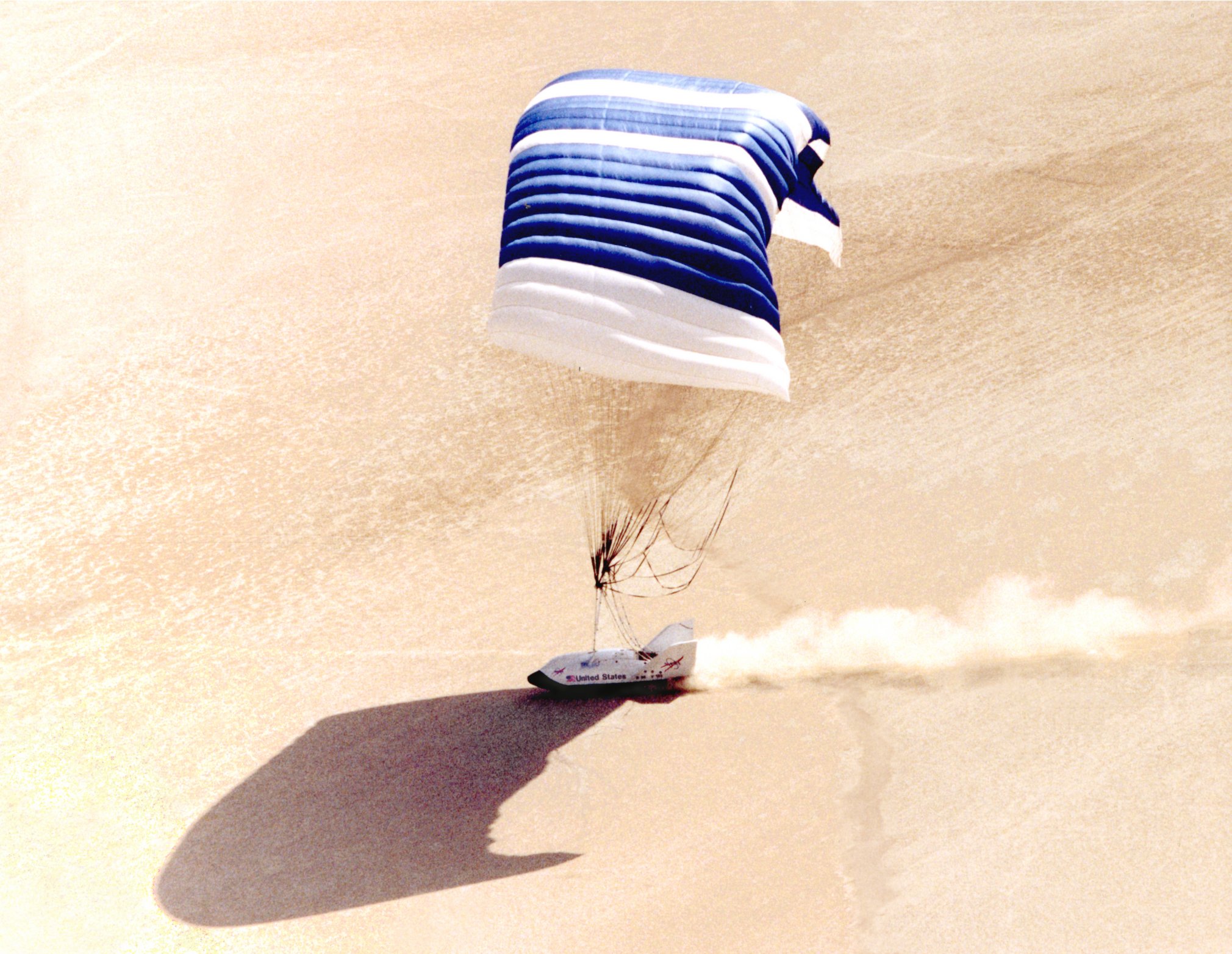
A NASA experiment in the late 90s examined the use of a parafoil to enable gentle, guided landings of an orbital escape pod – the experiment was quite successful. (NASA)
Ultimately, GPS-guided parafoils have been done fairly successfully and many times over during the past two or so decades. For the most part,the problems preventing SpaceX from recovering fairings in Mr Steven’s net have been almost entirely solved: the fact that two fairing halves have been recovered intact after their last two Western launches confirm as much. SpaceX engineers have somehow found a way to enable a highly flexible, lightweight, and aerodynamically awkward lifting body to survive a journey from heights of 110+ km and speeds of more than 2250 meters per second.
SpaceX’s fairings may look unassuming dressed in their subtle soot and simple curved lines, but – as SpaceX has intoned in the past – if landing massive Falcon 9 boosters after launch is akin to “launching a pencil over the Empire State building and having it land on a shoebox on the other side…during a wind storm,” recovering the relatively minuscule and light fairings can be fairly compared to launching a paper bowl over two stacked Empire State Buildings in a tornado and catching it with one hand behind your back on the opposite side – all without ripping, folding, or denting it.
- It may look unassuming, but that fairing half could swallow an entire school bus and by all means should not be in one piece. (Fairing from PAZ, photo by Elon Musk)
- Falcon 9 B1041.2 seen before launching Iridium-5. (Pauline Acalin)
SpaceX is 99% of the way to successful and routine fairing recovery and reuse and the final 1% is all about testing and subtle refinement. Future fairing recovery attempts may even be streamed in real time on SpaceX’s webcasts, according to Musk.
Follow us for live updates, behind-the-scenes sneak peeks, and a sea of beautiful photos from our East and West coast photographers.
Teslarati – Instagram – Twitter
Tom Cross – Twitter
Pauline Acalin – Twitter
Eric Ralph – Twitter

News
Tesla FSD fleet is nearing 7 billion total miles, including 2.5 billion city miles
As can be seen on Tesla’s official FSD webpage, vehicles equipped with the system have now navigated over 6.99 billion miles.

Tesla’s Full Self-Driving (Supervised) fleet is closing in on almost 7 billion total miles driven, as per data posted by the company on its official FSD webpage.
These figures hint at the massive scale of data fueling Tesla’s rapid FSD improvements, which have been quite notable as of late.
FSD mileage milestones
As can be seen on Tesla’s official FSD webpage, vehicles equipped with the system have now navigated over 6.99 billion miles. Tesla owner and avid FSD tester Whole Mars Catalog also shared a screenshot indicating that from the nearly 7 billion miles traveled by the FSD fleet, more than 2.5 billion miles were driven inside cities.
City miles are particularly valuable for complex urban scenarios like unprotected turns, pedestrian interactions, and traffic lights. This is also the difference-maker for FSD, as only complex solutions, such as Waymo’s self-driving taxis, operate similarly on inner-city streets. And even then, incidents such as the San Francisco blackouts have proven challenging for sensor-rich vehicles like Waymos.
Tesla’s data edge
Tesla has a number of advantages in the autonomous vehicle sector, one of which is the size of its fleet and the number of vehicles training FSD on real-world roads. Tesla’s nearly 7 billion FSD miles then allow the company to roll out updates that make its vehicles behave like they are being driven by experienced drivers, even if they are operating on their own.
So notable are Tesla’s improvements to FSD that NVIDIA Director of Robotics Jim Fan, after experiencing FSD v14, noted that the system is the first AI that passes what he described as a “Physical Turing Test.”
“Despite knowing exactly how robot learning works, I still find it magical watching the steering wheel turn by itself. First it feels surreal, next it becomes routine. Then, like the smartphone, taking it away actively hurts. This is how humanity gets rewired and glued to god-like technologies,” Fan wrote in a post on X.
News
Tesla starts showing how FSD will change lives in Europe
Local officials tested the system on narrow country roads and were impressed by FSD’s smooth, human-like driving, with some calling the service a game-changer for everyday life in areas that are far from urban centers.

Tesla has launched Europe’s first public shuttle service using Full Self-Driving (Supervised) in the rural Eifelkreis Bitburg-Prüm region of Germany, demonstrating how the technology can restore independence and mobility for people who struggle with limited transport options.
Local officials tested the system on narrow country roads and were impressed by FSD’s smooth, human-like driving, with some calling the service a game-changer for everyday life in areas that are far from urban centers.
Officials see real impact on rural residents
Arzfeld Mayor Johannes Kuhl and District Administrator Andreas Kruppert personally tested the Tesla shuttle service. This allowed them to see just how well FSD navigated winding lanes and rural roads confidently. Kruppert said, “Autonomous driving sounds like science fiction to many, but we simply see here that it works totally well in rural regions too.” Kuhl, for his part, also noted that FSD “feels like a very experienced driver.”
The pilot complements the area’s “Citizen Bus” program, which provides on-demand rides for elderly residents who can no longer drive themselves. Tesla Europe shared a video of a demonstration of the service, highlighting how FSD gives people their freedom back, even in places where public transport is not as prevalent.
What the Ministry for Economic Affairs and Transport says
Rhineland-Palatinate’s Minister Daniela Schmitt supported the project, praising the collaboration that made this “first of its kind in Europe” possible. As per the ministry, the rural rollout for the service shows FSD’s potential beyond major cities, and it delivers tangible benefits like grocery runs, doctor visits, and social connections for isolated residents.
“Reliable and flexible mobility is especially vital in rural areas. With the launch of a shuttle service using self-driving vehicles (FSD supervised) by Tesla in the Eifelkreis Bitburg-Prüm, an innovative pilot project is now getting underway that complements local community bus services. It is the first project of its kind in Europe.
“The result is a real gain for rural mobility: greater accessibility, more flexibility and tangible benefits for everyday life. A strong signal for innovation, cooperation and future-oriented mobility beyond urban centers,” the ministry wrote in a LinkedIn post.
News
Tesla China quietly posts Robotaxi-related job listing
Tesla China is currently seeking a Low Voltage Electrical Engineer to work on circuit board design for the company’s autonomous vehicles.

Tesla has posted a new job listing in Shanghai explicitly tied to its Robotaxi program, fueling speculation that the company is preparing to launch its dedicated autonomous ride-hailing service in China.
As noted in the listing, Tesla China is currently seeking a Low Voltage Electrical Engineer to work on circuit board design for the company’s autonomous vehicles.
Robotaxi-specific role
The listing, which was shared on social media platform X by industry watcher @tslaming, suggested that Tesla China is looking to fill the role urgently. The job listing itself specifically mentions that the person hired for the role will be working on the Low Voltage Hardware team, which would design the circuit boards that would serve as the nervous system of the Robotaxi.
Key tasks for the role, as indicated in the job listing, include collaboration with PCB layout, firmware, mechanical, program management, and validation teams, among other responsibilities. The role is based in Shanghai.
China Robotaxi launch
China represents a massive potential market for robotaxis, with its dense urban centers and supportive policies in select cities. Tesla has limited permission to roll out FSD in the country, though despite this, its vehicles have been hailed as among the best in the market when it comes to autonomous features. So far, at least, it appears that China supports Tesla’s FSD and Robotaxi rollout.
This was hinted at in November, when Tesla brought the Cybercab to the 8th China International Import Expo (CIIE) in Shanghai, marking the first time that the autonomous two-seater was brought to the Asia-Pacific region. The vehicle, despite not having a release date in China, received a significant amount of interest among the event’s attendees.
